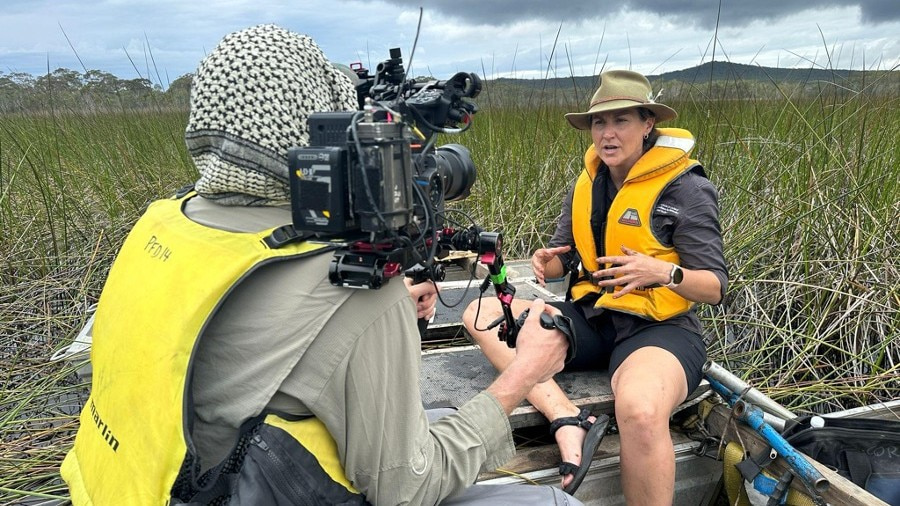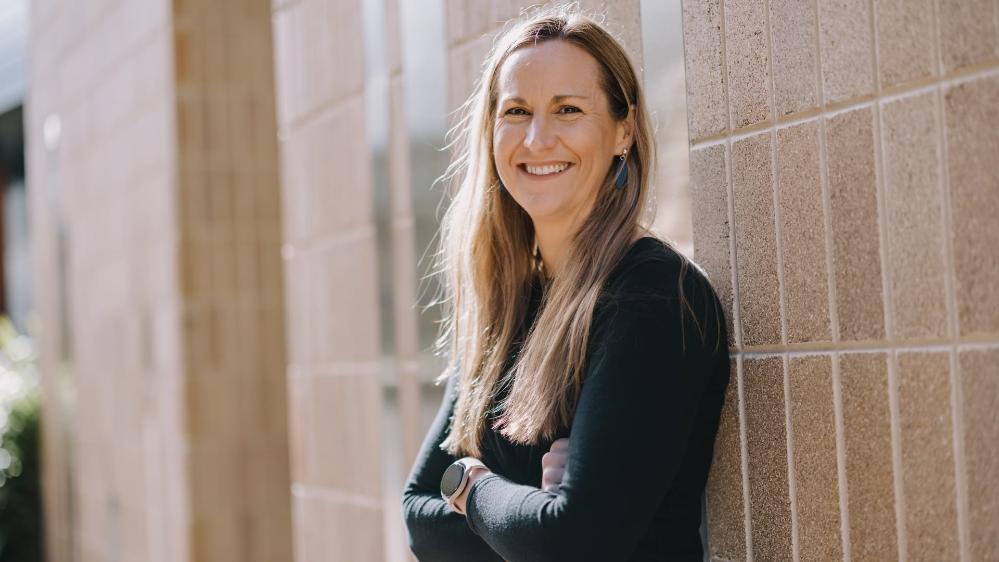June 25, 2024
Researcher helps uncover the mysteries of megafauna
Dr Haidee Cadd featured in new ABC documentary exploring extinction of Australia’s giant animals
The Earth holds many secrets. Dr Haidee Cadd, from the University of Wollongong’s (UOW) School of Earth, Atmospheric and Life Sciences, knows this more than most.
Much of her work as a palynologist studying plant pollen, spores and micro-organisms, focuses on using samples drawn from deep beneath the Earth’s surface to decipher the history of a landscape, to unravel the great mysteries of our time.
At the end of 2023, Dr Cadd found herself on North Stradbroke Island (Minjerribah), where the mystery, this time, was the death of Australia’s megafauna.
As a researcher in the Australian Research Council Centre of Excellence for Australian Biodiversity and Heritage which is headquartered at UOW, Dr Cadd had been invited to participate in a two-part documentary for ABC’s Catalyst.

Dr Haidee Cadd films the documentary on North Stradbroke Island in Queensland. Photo: Oliver Graham
Titled Megafauna: What Killed Australia’s Giants?, the program focuses on the extraordinary group of animals that once called Australia home. Narrated by actor Hugh Jackman, it airs on Tuesday 25 June and Tuesday 7 July, and is available on ABC’s iView.
Megafauna, Dr Cadd said, refers to animals that weigh more than 45kg. Australia was once home to a plethora of megafauna species, what would now be considered giant koalas, echidnas, kangaroos, lizards. After millions of years on Earth, they disappeared swiftly.
What led to the extinction of these giants has been a source of debate for more than a century in the scientific community. The documentary brings together scientists from around the world, including Dr Cadd, to investigate the ancient enigma.
Dr Cadd’s work has helped piece together parts of Australia’s environmental history, including periods when megafauna roamed the continent. She says she’s delighted her research has allowed her to take part in the groundbreaking documentary.
“Part of my PhD research aimed to answer the question of the extinction of Australia’s Pleistocene megafauna, and the role climate and landscape changes might have played, so I was keen to be involved. Was it the introduction of people to the land who hunted megafauna to extinction or was it shifts in the climate and landscapes?
“My research had focused on Welsby Lagoon on Minjerribah, which is a place that is rich with environmental changes in the dark organic peat,” Dr Cadd said.

She spent a day with ABC producers on North Stradbroke Island, off the coast of Brisbane, demonstrating how researchers core wetland sediments, a strenuous and painstaking process, to reveal its deep secrets. They were joined by Jonathan Marshall and Peter Negus from the Queensland Department of Environment and Science.
“Taking a sediment core from a water and reed-filled lagoon is challenging. The producers received a hands-on coring experience, helping us assemble the KAWHAW coring platform and push it through the dense macrophyte growth, undulating peat surface and waist-deep water.
“Filming the documentary was a remarkable experience. It’s rare to have the privilege to communicate science to such a wide audience and I was grateful to be given the chance.”
Dr Cadd is about to begin a three-year project funded by the Australian Research Council Discovery Early Career Researcher Awards. Her research will provide a greater understanding of Australia’s bushfire risk in the face of climate change by comparing fire occurrence in three Australian bioclimates across two millennial-scale time periods – prior to human settlement and during active Indigenous management – to unravel the benefits of cultural burning practices.
:format(jpg)/prod01/channel_3/assets/media-centre/Haidee-Cadd-2.jpg)